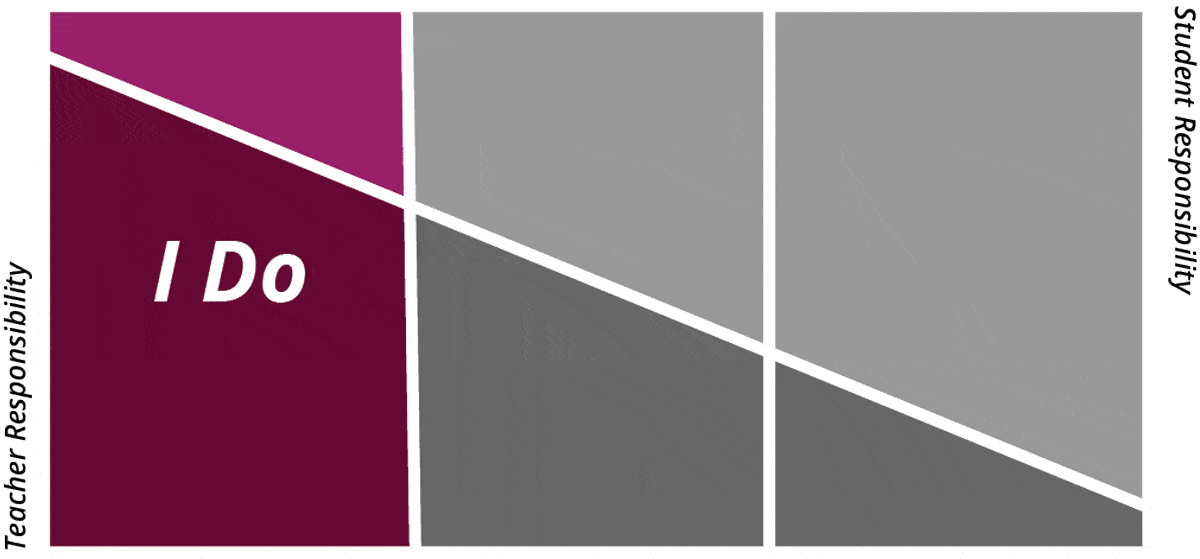The I Do – We Do – You Do model involves you in following a series of steps starting with you leading instruction and finishing with students working independently. In the I Do stage, you explain what students need to understand or model how to do a process. Then, in the We Do stage, you help your students by providing scaffolds such as prompts or partially completed procedures. Finally, in the You Do stage, your students do the procedure or show their understanding on their own.

Why You Should Use the l Do – We Do – You Do Model
When used well, the I Do – We Do – You Do model:
Helps all students to master what they need to learn
Suits novice learners (which most students are)
Nurtures self-efficacy
Reduces task anxiety
Students feel less anxious due to the clear modelling and the scaffolded opportunities to practice. These same factors help students to experience independent success, which in turn builds their self-efficacy1.
The I Do We Do You Do model is based upon the gradual release of responsibility from teacher to student.

Next, let’s explore each stage in more detail.

During the I Do stage of the I Do – You Do – We Do model, you tell your students about what they need to know and show them how to do the things they need to be able to do. Then, you check for understanding before moving on to the next stage.
I Do Procedural Learning
If you want to teach your students a procedure with steps, you should model completing those steps yourself.
This is true whether the procedure involves a younger student writing the letter m in cursive or a senior student keeping an historical research journal. Modelling is a powerful tool that draws on Albert Bandura’s Social Cognitive Theory. Modelling involves:
Demonstrating what to do by working an example
Sharing your thinking as you do so (think alouds)
Example
I Do Conceptual Learning
If you want to increase students’ knowledge and understanding of a topic, you need to explain it. Research on the modality and multimedia effects2 shows that you should explain things both:
Verbally
Verbal explanations should:
Activate prior understanding3
Be as simple as possible4
Break things down in a step-by-step manner4
Stress difficult points4
Show how concepts are distinct from similar concepts5
Accompanying visuals should:
Be shown at the same time as relevant verbal points6
Be directly relevant to your verbal explanation7
Contain minimal text7
Integrate any text within them (no legends)8
Organise information (sequence, comparison, cause-effect, hierarchy)9
NOT include sentences or points that you just read out7
Example

During the We Do stage of the I Do – We Do – You Do model you scaffold tasks and guide students as they work with the material you have taught them. You also offer incidental feedback and gauge students readiness to move to the next stage.
We Do Procedural Learning
While worked examples are a key aspect of the I Do stage, faded worked examples10 are an essential aspect of the We Do stage. With faded worked examples:
You complete some of the steps
Your students complete the remaining steps
The examples are faded as you start by completing many of the steps yourself and progressively get your students to more steps with each example.
Examples

We Do Conceptual Learning
The key to conceptual learning is getting your students to think about the material they need to understand. This involves helping them encode and retrieve the material in an organised way. Within the We Do stage of the I Do – We Do – You Do model you provide support through prompting comparative and organised thinking. You can make use of partially completed information and have your students fill in the gaps.
You can help your students encode information by getting them to:
Consider how new information adds to and changes what they previously understood
Think about what makes new concepts distinct from similar concepts
Organise material without having to remember it (e.g., outlining, note-taking, concept mapping)
You can help your students retrieve information using 2 strategies:
Recognising material (e.g., multiple choice questions, sort activities, match activities)
Recalling material with prompts (e.g., cloze exercises with prompts, completing a concept map with prompts)
You can also do this:
On the board (or screen) with the whole class
By giving your students partially completed handouts to finish
Example

During the You Do stage of the I Do – We Do – You Do model your students complete tasks independently, but only tasks similar to what you have covered in earlier. Afterwards, you give them feedback on their independent work.
Tasks that you have covered earlier
When you believe they will succeed on their own
Moving into the You Do stage too early can lead students to guess and lower their self-efficacy for the types of tasks that you are asking them to do.
You Do Procedural Learning
With You Do activities as the procedural level, you simply have your students complete all of the steps involved in the task themselves.
Some people ask if you should get your students to apply what they have learned to solve problems at this stage. The answer depends on whether you showed them how to so and then did so together in earlier stages.
You Do Conceptual Learning
At the conceptual level, You Do activities involve recalling information without prompts. This can involve:
Answering short answer questions
Answering long answer questions
Creating mind maps
Retrieve-taking12
You Do Conceptual Example

More Than Just A Lesson Structure
Many people think of the I Do We Do You Do model as a way of structuring a single lesson, and it can be. Yet, it can also be much more. The structure can also occur:
More than once within a single lesson
Once over a series of lessons
When you believe your students will find lesson material to be quite challenging, you can break it up into more manageable chunks. You follow the the I Do – We Do – You Do structure for each chunk and may get a few chunks covered within a single lesson.
By contrast, you can also use the structure over several lessons. Especially as students get older, learning doesn’t occur over a single lesson, so you follow the structure over a small series of lessons – with each lesson picking up from where the previous lesson finished.
Beyond the I Do We Do Model
The essence of the I Do We Do You Do model is scaffolding tasks as your gradually release responsibility to your students. Yet, many of the strategies listed above are grounded in research that fits nicely with, but is separate from, the I Do We Do You Do model, particularly:
Cognitive load theory
Teacher clarity
Multimedia learning
Retrieval practice
However, there is one potent strategy that wasn’t mentioned. It is a simple but powerful strategy – spaced practice (also known as distributed practice). Below, this is shown as a new stage Do Again (and again, and again).

Beware
You can adapt the model but some adaptations fly in the face of strong research. Be particularly wary of:
Rapid release of responsibility models
Confusing ‘we do’ to mean collaborative learning
The rapid release of responsibility model turns the I Do We Do You Do model on its head and starts with the You Do stage. It is a euphemism for inquiry learning (and its cousins discovery learning and problem-based learning). The research is clear that while experts learn well from such approaches, novice learners do not. Most school students are novices in what they are learning, although they build expertise as they progress. As a result, you should not use inquiry learning with novice learners. Experts are competent in both the material and the processes or procedures involved.
You should also be wary of the we do stage being confused with collaborative learning. Collaboration can extend the model in useful ways, but the essence of the we do stage is teacher + student, not student + student. That said, some productive ways to use collaboration within the I Do We Do You Do model are:
Retrieval pairs (we do stage)
Brain Dump 1-2-4 (you do stage)
1 Person per Step (do again stage)
Retrieval Pairs
One example of retrieval pairs would be flash card buddies, where one student holds up a card (or paper) with an explanation of a concept on the side facing their buddy and the name of the concept on the side facing them. Next, their student gives their buddy the first sound of the answer or of each word (prompts). The buddy answers and gets told if they were right or wrong, as well as the correct answer. The process repeats with different concepts and with students reversing roles. You could use a similar process with other retrieval exercises, such as prompted concept mapping. The teacher involvement in this stage is largely about preparing cards or other prompts.
Brain Dump 1-2-4
Students write down everything they can remember from a lesson or topic (brain dump 1). Then students pair up (brain dump 2), discuss each others’ brain dumps, then make corrections and additions based on that discussion. They agree on a single, merged brain dump. Pairs then join with another pair (brain dump 4) and repeat the discuss and amend process. Note although there are 4 people in the group they are only discussing 2 merged brain dumps from the previous stage.
1 Person per Step
If your students are learning a multi-step procedure such as 2 digit by 2 digit multiplication you can use the one person per step strategy. 2 digit x 2 digit multiplication has 3 steps:
Multiply the top number by the ones
Multiply the top number by the tens
Add the answers from steps 1 and 2 together
Place you students into groups of 3, then have each person complete one step. Give your students at least 3 problems to solve and have them rotate the step they do each time. For uneven groups, one person may do 2 steps (groups of 2 are better than groups of 4). Note, you should use this strategy after your students have done independent practice as it reduces social loafing.


